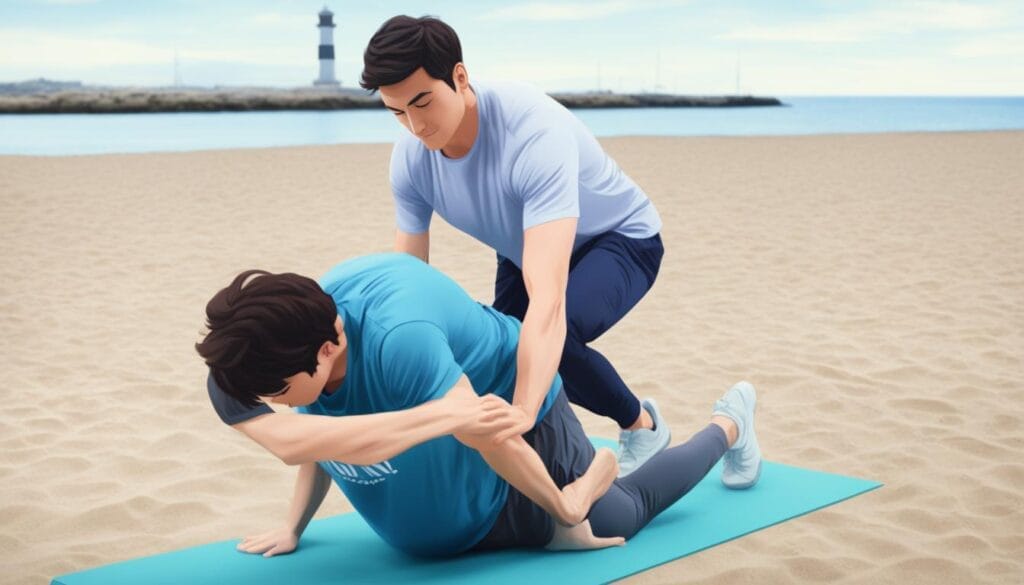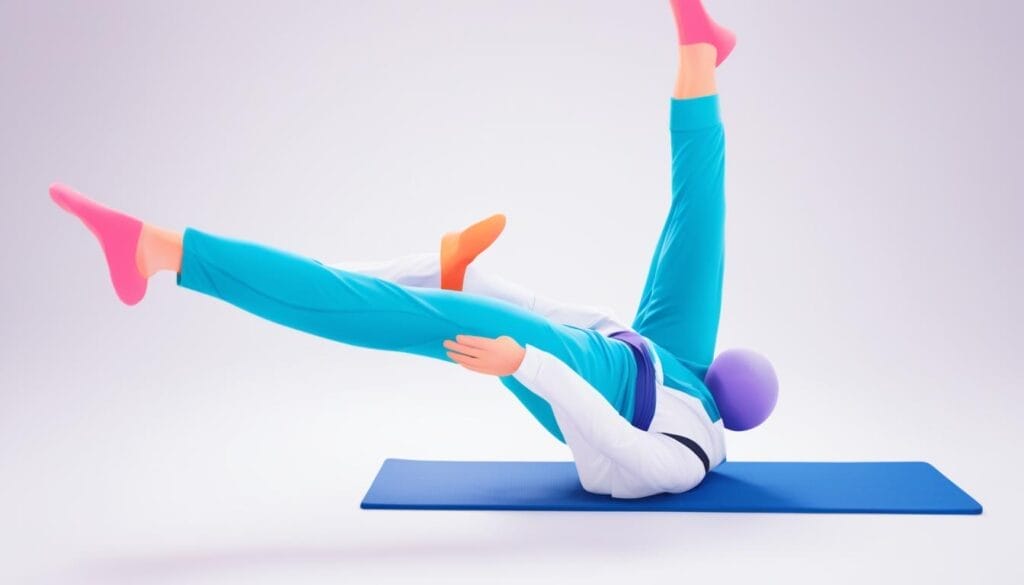Flexibility is key for improving your running efforts. It’s not just about the distance you cover but having a body that’s agile. During marathon training, I faced issues due to tight muscles. These problems slowed me down and led to injuries.
Adding stretches to my routine changed everything. I felt lighter when running. Pain and aches lessened, and I could run better and further. Flexibility truly became my secret to running without getting hurt.
I’m keen to offer my advice on enhancing flexibility for runners. Whether you’re into marathons or are a beginner, these tips are for you. They’ll help you get the most out of your body and improve your running game. Now, let’s explore the benefits of being flexible as a runner.
Key Takeaways:
- Flexibility is a crucial element for optimal running performance.
- Stretching and incorporating a flexibility training program can reduce the risk of injuries.
- Regular stretching sessions and foam rolling improve flexibility for runners.
- Flexibility is closely linked to running economy and overall performance.
- Consistency is key in improving flexibility for runners.
The Benefits of Flexibility for Runners
For runners, flexibility is vital. It brings many benefits like better performance and less chance of getting hurt. As a runner, I’ve seen how being flexible makes a difference.
Flexibility helps runners improve how they run, or their running economy. It lets your hips and ankles move better, which is key for running. This makes running smoother and more effective.
It also makes sure your body moves right when you run, keeping your muscles balanced and not too tight. This lowers the risk of common injuries like strains. Flexible muscles handle running stress better, cutting the chance of doing too much and getting hurt.
Besides, staying flexible helps you keep a good running shape. When your muscles can stretch out fully, your every step is stronger and more efficient. This leads to better achievements in your runs.
“Flexibility is the key to running with ease and reducing the risk of injuries. It allows for better range of motion, preventing muscle imbalances and promoting efficient running mechanics.”
Adding flexibility training to your running boosts your results. It’s important to do stretches for both before and after your run. Tools like foam rollers can also help by softening up your muscles.
“The combination of stretching exercises and foam rolling can greatly improve flexibility for runners, minimising the risk of injuries and optimising performance.”
Few points to bear in mind. Flexibility doesn’t come easy. It takes regular work and commitment. By focusing on flexibility, you can make your runs smoother and better. Look after your body, get more flexible, and max out your running strength.
Stretching for Runners – Key Exercises
Stretching is vital for runners to boost flexibility. It widens muscle and joint movement, leading to better performance and lower injury chances. Doing stretches after running cuts muscle soreness and ups flexibility. Here are some top exercises for runners:
Lying Hamstring Stretch
Get on your back, lifting one leg straight up. Grip the thigh behind with both hands, pulling the leg towards you. Feel the back leg stretch. Switch legs after 30 seconds.
Lying Glute Stretch
Lie down with knees bent. Cross left ankle over right knee and pull right knee towards chest. Hold the right thigh and gently pull both legs. Feel a glute stretch. Swap legs every 30 seconds.
Groin Stretch
Sit, feet together, knees to the sides. Grab your ankles, gently pushing knees down. This stretches the inner thighs. Hold for 30 seconds.
Straight Leg Calf Stretch
Stand facing a wall with hands on it. Step one leg back, keep it straight, heel down. Lean ahead, sensing a calf stretch. Change legs after 30 seconds.
Soleus Stretch
Stand facing a wall, hands on it. Step back with one leg, bend the knee. Keep the heel down and lean for a calf stretch. Alternate legs after 30 seconds.
Hip Flexor Stretch
Kneel with one foot on the floor in front. Push hips forward, feeling a front hip stretch. Change sides after 30 seconds.
Standing Quadriceps Stretch
Stand and pull one foot towards your buttocks. Use your hand to gently stretch the thigh’s front. Swap legs every 30 seconds.
Kneeling Quadriceps Stretch against a Wall
Kneel with one foot against a wall. Reach back, pulling the foot towards your buttocks. Switch sides every 30 seconds.
Bent-Leg Standing Hamstring Stretch
Stand and put one foot on a bench. Lean forward to stretch the thigh’s back. Change sides after 30 seconds.
Cross-Legged Sitting Glute Stretch
Sit with legs crossed. Press gently on the top knee for a glute stretch. Alternate every 30 seconds.
Downward-Facing Dog
Start on hands and knees. Lift hips to form an inverted V. Aim to press heels to the floor, stretching legs and back. Hold this position for 30 seconds.
Lying Spinal Twist
Lie down, arms to sides. Drop knees to one side, keeping shoulders down. Turn head opposite the knees for a back stretch. After 30 seconds, switch sides.
Forward-Bend Shoulder Stretch
Stand with feet apart. Lace fingers behind your back, arms straight. Bend forward gently from your waist. Feel the stretch in your shoulders and upper back. Hold for 30 seconds.
Do these stretches after your run to boost flexibility and reduce soreness. Remember to breathe deeply, start each stretch gently, and pay attention to what your body tells you. Enjoy your runs!

| Exercise | Instructions |
|---|---|
| Lying Hamstring Stretch | Lie on your back and extend one leg straight up. Hold the back of your thigh with both hands and gently pull your leg towards your chest. |
| Lying Glute Stretch | Lie on your back with both knees bent. Cross your left ankle over your right knee and bring your right knee towards your chest. Hold behind your right thigh and gently pull your legs towards your chest. |
| Groin Stretch | Sit on the floor with your feet together and bend your knees out to the sides. Hold your ankles and gently push your knees down towards the floor until you feel a stretch in your inner thighs. |
| Straight Leg Calf Stretch | Stand facing a wall and place your hands on the wall for support. Step one foot back and keep your leg straight. Press your heel into the ground and lean forward, feeling a stretch in your calf. |
| Soleus Stretch | Stand facing a wall and place your hands on the wall for support. Step one foot back and bend your knee. Keep your back heel on the ground and lean forward, feeling a stretch in your lower calf. |
| Hip Flexor Stretch | Kneel on one knee and place the other foot flat on the ground in front of you. Press your hips forward until you feel a stretch in the front of your hip. |
| Standing Quadriceps Stretch | Stand tall and bring one heel towards your buttocks with your hand. Gently pull your foot towards your buttocks until you feel a stretch in the front of your thigh. |
| Kneeling Quadriceps Stretch against a Wall | Kneel on one knee and lean back against a wall. Bring the opposite foot up towards your buttocks and hold onto your foot with your hand, gently pulling it towards your buttocks. |
| Bent-Leg Standing Hamstring Stretch | Stand tall with your feet shoulder-width apart. Bend one knee and rest your foot on a chair or bench. Lean forward from your hips until you feel a stretch in the back of your thigh. |
| Cross-Legged Sitting Glute Stretch | Sit on the floor with your legs crossed. Place your right ankle on your left knee and gently press down on your right knee until you feel a stretch in your glutes. |
| Downward-Facing Dog | Start on your hands and knees with your palms flat on the ground. Lift your hips up towards the ceiling, straightening your legs and forming an inverted V shape with your body. |
| Lying Spinal Twist | Lie on your back with your arms extended out to the sides. Bend your knees and drop them to one side, keeping your shoulders on the ground. Gently rotate your head in the opposite direction to deepen the stretch in your back. |
| Forward-Bend Shoulder Stretch | Stand tall with your feet hip-width apart. Interlace your fingers behind your back and gently lift your arms up as you bend forward at the waist, letting your arms fall towards the ground. |
The Role of Flexibility in Running Performance
Flexibility is vital to boost running performance. It helps muscles stretch, improves how far you can move and keeps joints stable. When you run, adding flexibility exercises to your routine can really help.
Being more flexible means you can take longer steps, get less tired, and run better. A good routine includes still and moving stretches, aiming at muscles you use when running.
Still stretches like standing and kneeling ones can make your muscles stretch more and let your body move further. Hold each still stretch for 15 to 30 seconds and do it a few times.
Moving stretches like lunges, high knees, and leg swings get your body ready to run. They make your muscles warm and set for action.
Stretching doesn’t just stop injuries. It also makes your muscles work better, improving how well you run.
Don’t forget the specific muscles you need for running, like hips and legs. Working these out makes them stronger and more flexible, helping you run better.
| Flexibility Training Program | Benefits |
|---|---|
| Static and dynamic stretches | Improved muscle elasticity and range of motion |
| Exercises targeting specific muscle groups | Enhanced stride length and reduced muscle fatigue |
It’s vital to keep at the flexibility exercises regularly. Aim for at least three times a week in your workouts. Consistency helps your muscles get used to stretching and become more flexible.
Put effort into flexibility, and you will see big gains in your running performance. Make stretching part of a full flexibility program, and run towards your goals.
Tips for Improving Flexibility
Runners don’t need to be as flexible as gymnasts, but it pays to improve. Regular stretching, foam rolling, and using self-myofascial tools help. You should also see a physical or massage therapist for specific issues.
Sustained effort improves flexibility and lessens injury risks over time. It’s a step-by-step journey.
Here are some top flexibility tips for those who love running:
- Regular stretching sessions: Get into the habit of stretching after you run. Focus on the main muscles used for running. This includes the calves, hamstrings, quads, and hip flexors. Hold each stretch for 20-30 seconds but don’t bounce or push too hard.
- Foam rolling: Make foam rolling part of your routine to loosen up muscles and boost flexibility. Roll over each muscle group carefully, stopping on any sore spots. Remember to treat both sides of your body equally.
- Self-myofascial relief tools: Alongside foam rolling, using tools like massage balls is great for tight spots.
- Seek professional help: If you’ve got continuous problems or specific tightness, seeing a therapist is wise. They offer focused stretching and soft tissue work to improve flexibility and sort out issues.
- Consistency: Know that becoming more flexible takes dedication. Be regular and patient with your stretching and strength work. Try to do a flexibility session 3-4 times every week.
Stick with these tips and you’ll see your body movement get better. This helps make your muscles work together smoothly and makes you a better runner. Always remember, being flexible is a journey. Stay devoted and enjoy the benefits of more flexibility and fewer injuries.

| Flexibility Tips for Runners | Benefits |
|---|---|
| Regular stretching sessions | Improves muscle elasticity and range of motion |
| Foam rolling | Relieves muscle tension and improves flexibility |
| Self-myofascial relief tools | Targets specific areas of tightness and tension |
| Seek professional help | Provides targeted stretching and soft tissue techniques |
| Consistency | Creates lasting flexibility gains |
Flexibility and Injury Prevention
Being flexible is key for runners to stay injury-free. If your muscles are tight, you’re more likely to get hurt. This is because tightness can cause imbalances, strains, and overuse injuries. Good flexibility when running means less stress on your body’s joints and muscles. It also helps your body absorb impact better, lowering the chance of injuries like strains and tears.
Flexibility is crucial for keeping runners safe. When you run, your body moves in repetitive ways that stress muscles and joints. If you’re not flexible, this can lead to tightness, imbalances, and strains. This makes you more likely to get hurt.
Focusing on being flexible helps runners avoid many common injuries. It enables a wider range of motion, which reduces the stress on your joints and muscles. Flexible muscles act as shock absorbers. They help spread out impact forces. This stops strains and tears from happening.
“Maintaining good flexibility is like giving your body a safety net. It allows you to move freely, with reduced tension and strain, ultimately helping to prevent injuries.”
Becoming flexible takes time and work. You need to stretch the muscles you use while running. This includes exercises for your hamstrings, hip flexors, and calves. Doing these exercises often boosts your flexibility and wards off imbalances.
Also, warming up before running is essential. A dynamic warm-up, with exercises like leg swings and lunges, prepares your body. It makes your muscles more flexible, cutting down the injury risk.
Strength training complements flexibility work. Strong muscles support your joints, making them more stable. Exercises for your core and hips are particularly helpful. They increase flexibility and lower your chances of getting hurt while running.
Focusing on flexibility is a must for runners. Doing so can prevent imbalances, improve how you move, and protect you from running’s wear and tear. It’s vital for a healthy, active running routine without injuries getting in the way.

Flexibility and Injury Prevention Methods
| Flexibility Method | Description |
|---|---|
| Stretching Exercises | Perform specific stretches targeting muscles used in running to improve flexibility and reduce imbalances. |
| Dynamic Warm-up | Incorporate dynamic stretches before each run to prepare muscles for movement and enhance flexibility. |
| Strength Training | Include exercises that strengthen core, hips, and lower body to provide better support to joints and maintain proper alignment. |
| Consistency | Make flexibility training a regular part of the running routine to maintain and improve flexibility over time. |
| Listen to the Body | Pay attention to any signs of tightness or discomfort and adjust stretching or training accordingly to prevent injuries. |
The Relationship Between Flexibility and Running Economy
Flexibility is key for top running performance. It’s linked to how efficiently we run. This link is known as running economy. Better flexibility means running costs less energy. You’ll go further and faster.
Flexibility Tips for Runners:
- Regular stretching sessions: Add in regular stretching for better flexibility. It helps muscles lengthen. This makes moving easier.
- Foam rolling and self-myofascial relief tools: Use foam rollers and tools for self-massage. They reduce muscle tightness. This boosts your flexibility and movement.
- Partnering with a professional: A therapist or massage expert can help. They’ll tackle your body’s specific issues. Their advice and treatments will make you more flexible and lower injury risk.
Good flexibility lets your body use energy well. Mismatched muscles and tissue aren’t efficient. But when they work in harmony, your steps are powerful and light. This is the heart of better running economy.
It’s not just about extreme stretches or poses. The goal is to move freely where it counts, like the hips and core. This is what boosts your running success.
To up your running game, focus on being flexible. Add stretch and self-care tools to your routine. When needed, get expert help. With a flexible body, you’ll run with less effort and achieve more.

| Benefits of Flexibility for Runners |
|---|
| Improved running economy |
| Reduced energy expenditure |
| Enhanced overall performance |
| Better range of motion in key areas |
| Prevention of muscle tightness and imbalances |
| Easier adaptation to proper biomechanics |
Summing It Up
Flexibility is vital for runners. It helps prevent injuries and boosts performance. By stretching, using foam rollers, and self-myofascial tools, you can get more flexible. This improves how far your joints move and your muscle stretch, making your running smoother. It also lowers the chance of muscle problems and helps you meet your running goals.
Making flexibility exercises a habit is important. Your flexibility will grow slowly if you keep at it. This will make your running better and safer. So, focusing on being more flexible in your training will really pay off.
Don’t wait to start working on your flexibility in running. Add these exercises to your routine and you’ll see improvements in how you run. Taking care of your flexibility is taking care of your performance. Enjoy the benefits of being a flexible runner.
FAQ
What is flexibility and why is it important for runners?
Flexibility is our body’s ability to move freely. It’s key for runners. It lessens injury chances, betters running efficiency, and ensures correct movement while running.
What are the benefits of flexibility for runners?
It enhances how you run, lowers the injury risk, and boosts your performance. Plus, it keeps muscles balanced and prevents them from becoming too tight.
Which stretching exercises are recommended for runners to improve flexibility?
Good stretches for runners include hamstring, glutes, and groin stretches. Also, don’t forget to stretch your legs, hips, and upper body. These exercises help keep you limber.
How does flexibility impact running performance?
Being flexible makes your muscles and joints work better. This means you can run smoother, further, and with less effort. It’s a big deal for how well you do in a race.
What tips can help in improving flexibility for runners?
Doing stretching often is crucial. Use tools like foam rollers to help. Working with experts, like therapists, can also make a big difference. This all helps you move better and prevents injuries.
How does flexibility contribute to injury prevention for runners?
When you’re flexible, you’re less likely to hurt yourself. It stops muscles from pulling too hard, which can cause a problem. Plus, it lets your body deal with the shock of running without getting hurt.
What is the relationship between flexibility and running economy?
If you can move well, you don’t use as much energy to run. Having supple muscles and joints helps your body move more efficiently. This means you can run stronger and longer.
What is the significance of flexibility for runners?
Flexibility is everything for a runner. It prevents injuries, makes you run better, and helps you reach your running dreams. Keeping flexible is the secret to success on the track.
Source Links
Share Me:
READY TO UNLEASH
YOUR BEST SELF?
Click “Sign Me Up!” And Start Your Fitness Transformation!





